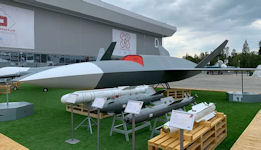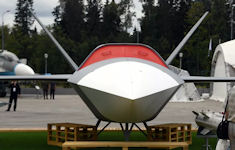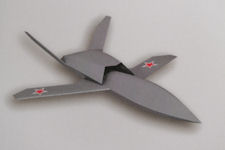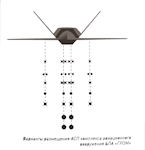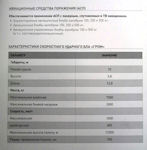Grom Unmanned Aerial Vehicle
The Grom (Thunder) drone, presented for the first time at the Army-2020 forum, is designed to support the Su-35 and Su-57 fighters. The static display model was, in candor, not overly convincing, as it lacked landing gear but was propped up on boxes. The foreign counterparts of Thunder are the American XQ-58 Valkyrie UAV, which is being developed by the American company Kratos, as well as the Loyal Wingman UAV, which is being created by the Australian division of Boeing. The version of the“ unmanned slave proposed by the Kronstadt company is somewhat superior in terms of weight and dimensions to the conceptually close foreign counterparts. However, in the future, variants of a different dimension may be implemented.
Nikolai Dolzhenkov, general designer of the aircraft development company Kronstadt, told RIA Novosti 24 August 2020 "Already today, the Ministry of Defense has an understanding that drones of this type should en masse enter service with the Aerospace Forces," Dolzhenkov stressed. As indicated on website exhibition "Army-2020", high-speed shock turbojet UAV "Thunder" is designed to work as a "slave" in the forward attacking echelon in cooperation with manned aircraft.
Major aviation and military technical exhibitions this year were either postponed (HELIRUSSIA 2020) or canceled altogether (International Engine Engineering Forum MFD-2020, Hydroaviasalon 2020). But the main event of the year in this area - "Army-2020" - took place despite the restrictions. Allegedly, the UAV "Thunder" was also shown, but there are no pictures on the network. On the plan of the exposition in Kubinka, there is the mark "Thunder-2" (not "Thunder"). Also "Lightning". The schematic contour of "Thunder-2" on the plan strongly resembles the Barracuda UAV. And this is the entire exposition of "Kronstadt".
The Thunder unmanned high-speed attack aircraft, which is presented for the first time at the Army-2020 forum, is capable of interacting with a manned aircraft. Sergei Bogatikov, General Director of Kronshtadt JSC, told the Zvezda TV channel about this. “This is the so-called follower. Three or four Thunder-type vehicles can and should be controlled from a manned aircraft,” he said.
Bogatikov also revealed the tasks to be solved by the newest drone. “The tactics of use are as follows: unmanned aircraft are moving ahead and solving the tasks of suppressing air defense systems, and they are getting away from the attack. That is, these devices are equipped with appropriate guided weapons,” he stressed.
Now this is a very fashionable trend in the development of unmanned aircraft for a similar purpose. Such works are carried out in the USA and European NATO countries. It is also known that the Russian UAV "Okhotnik-B" by the "Sukhoi" company was recently tested together with the 5th generation fighter Su-57. and here is a new development on this topic. It is noted that the new Thunder drone will ensure the opening and destruction of military air defense systems, as well as the defeat of ground, surface and coastal targets by guided high-precision ammunition, and will carry out reconnaissance missions.
As the recent events in Syria and Libya had shown, when the Turkish armed forces began to massively use attack drones, the presence of a UAV of this type can change the nature of hostilities and affect the results of the entire military campaign. Probably, this also became clear to our military, engineers and designers. Interestingly, in addition to purely shock missions, "Thunder" will be able to be controlled by combat aircraft. And this will significantly increase its combat effectiveness and increase the capabilities of the front-line aviation itself.
Such UAVs, in addition to reconnaissance tasks, can also be used for the tasks of opening the enemy's military and object air defense and to defeat the corresponding complexes. They can also be used to strike other high-priority targets located in the tactical and operational-tactical depth of the enemy's defense, including ground-based mobile and stationary targets, as well as surface and coastal targets.
The Grom will be capable of using a wide range of weapons, in particular the new Product 85 guided missile, as well as the KAB-250 and KAB-500 guided aerial bombs. The high-speed attack unmanned aerial vehicle "Thunder" will be capable of carrying X-38 guided air-to-surface missiles. According to the Tactical Missile Armament Corporation, the Kh-38 missile has a modular design and, depending on the combat mission, is equipped with one of four seeker heads. Its range reaches 70 km, and its flight speed is over 2 M. Several types of warheads have been developed for the missile, including high-explosive fragmentation and penetrating ones.
According to the company "Kronstadt", the shock capabilities of the drone "Thunder" are associated with the presence of four points of suspension - two under the wing consoles and two - inside the fuselage. According to official data, with a take-off weight of 7 tons, it will be able to deliver a payload weighing 1.3 tons at a distance of 800 km. Grom will also be able to use a wide range of weapons, in particular the new product 85 guided missile and the KAB-250 and KAB-500 guided bombs.
Grom will be able to control a swarm of 10 Molniya attack drones. Small-sized UAVs "Molniya" are intended for high-precision destruction of stationary and mobile ground targets, use as decoys to complicate the air situation, suppress enemy air defenses, create and control the breakthrough band of a strike group and promptly destroy suddenly detected air defense targets, provide group electronic warfare when performing tasks together with manned aircraft.
The Russian unmanned aerial vehicle (UAV) "Grom" will be able to control a swarm of 10 small-sized "Molniya" drones in reconnaissance and strike configurations with the ability to change tasks for each member of the group. This was reported to TASS 15 March 2021 by a representative of the Kronstadt JSC, which develops the Thunder.
"The returned ones are reconnaissance drones. Strike drones, as in the case of loitering ammunition, are kamikaze. The lightning bolts will constantly communicate with each other and the carrier drone," the Kronstadt spokesman said. According to him, "Lightning" is optimized for use as part of a swarm of drones. "Lightning has a constant data exchange between UAVs. It is possible to change tasks for each member of the flock. Transfer of leadership roles and interchangeability. At the same time, thanks to artificial intelligence, the task is performed by a group without constant communication with the carrier aircraft," the company said.
https://telegra.ph/BPLA-Grom---vtoraya-iteraciya-08-23">UAV "Thunder" - second iteration. Military InformantAugust 23, 2024 Grom-U The Grom jet attack drone is positioned as a means of destroying air defenses, but some analysts doubt its prospects. The device could have been created on the basis of the Soviet Tu-141 "Strizh". The characteristics of the UAV were revealed by the portal "Russkaya Gazeta". The cost/effectiveness ratio raises questions in the possible use of the "Grom" jet UAV during the war with Ukraine. Russian high-explosive aerial bombs equipped with unified planning and correction modules (UMPK) are one of the most effective types of weapons used during the special military operation (SVO) in Ukraine. In addition, the "Grom" has a competitor in the form of a similar project, the S-70 "Okhotnik". Among the flying exhibits presented at the Military-Technical Forum "Army-2024", the high-speed strike unmanned aircraft "Grom" stood out. It is reportedly capable of acting as a wingman in the forward attack echelon, closely interacting with aircraft in which real pilots will be located. This UAV can destroy various types of air defense systems using anti-radar missiles. It is also capable of destroying surface and coastal targets in tactical and operational-tactical depth. A new Russian mockup of a ‘loyal wingman’-type drone was unveiled at the Army 2024 defense exhibition in the Moscow region 12 to 14 August 2024. The firm Kronshtadt that designed this year's Grom (meaning Thunder) displayed a different UCAV concept under the same name at Army-2020. Its takeoff weight is up to 7 tons with a body length of about 14 meters and a wingspan of up to 10 meters. Its estimated flight range is about 1,400-2,000 kilometers, which seemed realistic. The payload weight is up to 2,000 kilograms. An aspirational foray into unmanned combat air vehicles (UCAVs), the new fighter-like version of the Grom is very different, apparently stressing aerodynamic performance, especially in the transonic realm, over low-observable features and endurance. The updated version of the drone is unofficially called Grom-U, and is being designed to function as a drone wingman for Russia’s manned aircraft such as the Su-35 and Su-57 fighters. The drone is designed to reach top speeds of 600 miles per hour (1000 km per hour) and it has a reported operational radius of 500 miles (800 kms approximately, the company reports 700km). The Grom can also carry loads of between 2200 pounds (1000 kg) to 4400 pounds (2000 kg) for operations, which includes missiles, bombs and other technical equipments. The new Grom drone will be able to independently perform combat missions, even while in the air defense zone, Air Force Major Andrei Krasnoperov told NEWS.ru. In this way, the Russian Aerospace Forces will be able to reduce the risks for pilots in combat zones, he believes. The drone can find a target, carry a certain combat load and drop bombs on the enemy according to a given program. The maximum lifting force allows it to fly for a long time , the expert says. The course of the special military operation showed that there is a huge demand for drones, the expert noted. According to him, this concerns not only small reconnaissance, patrol or FPV drones, but also large ones, like aircraft. The active use of drones allows the Russian Armed Forces to knock out English, German, and American tanks with these drones. If we take the ratio of the cost of these tanks and the cost of drones, then a drone is not even several times, but hundreds, if not a thousand times cheaper than a tank, on which almost a billion dollars were spent , Krasnoperov summed up. The new Russian drone was noticed by experts from the Defence Express portal, who noted its similarity to the Russian attack jet UAV project Tu-300 "Korshun" of the 1990s, which was planned on the basis of the Tu-141 "Strizh". As part of the aforementioned project, the Russian Federation tried to turn the "Strizh" into a carrier of unguided aerial bombs, but the development was never implemented. Analysts believe that the developers of the Korshun were unable to explain to the Russian Defense Ministry how they were going to resolve issues with the suspension of weapons on the Tu-300 and the subsequent launch of this UAV. At the same time, the publication does not rule out that the Tu-300 project could have been used as a basis for the creation of the Grom. The Kronstadt Group unites a number of Russian enterprises specializing in the development and production of high-tech and science-intensive products and solutions necessary for the creation, development and safe operation of complex technical equipment in the air, at sea and on land. Kronstadt's developments include the Orion reconnaissance and strike drone , the Sirius strike drones and the Grom heavy UAV. The company also designs onboard equipment and payloads for drones, software and hardware systems for navigation and control, etc. Dubna Machine-Building Plant (DMZ) became the property of Kronstadt in July 2021, and a new drone production plant was built by Kronstadt next to DMZ in record time - from April to December 2021. Both enterprises form the Unmanned Aviation Center, whose task is to produce both the unmanned vehicles themselves and ground control stations. The center produces the Orion drone, the version for the armed forces is the Inokhodets. It was developed by order of the Russian Ministry of Defense . The Russian plant for the serial production of reconnaissance and strike drones in Dubna will operate in three shifts. This was announced at the end of June 2022 by the deputy general director of the company that owns the enterprise, the Kronstadt Group, Alexey Belykh, at a meeting with employees of the Dubna Machine-Building Plant (DMZ). According to him, in connection with the increase in production, Kronstadt continues to recruit personnel, and offers applicants partial compensation for housing rent, assistance with transportation, special clothing and voluntary health insurance policies. For young specialists and workers without experience, the company is implementing mentoring and training programs, said Alexey Belykh. Investments in the project are estimated at more than 4 billion rubles . Kronstadt noted that the enterprise will provide permanent employment for more than 1,500 people and will direct more than 900 million rubles in annual tax deductions to budgets at various levels. It is assumed that this will be an environmentally friendly and noiseless production facility with an area of about 45,000 square meters. On February 16, 2021, it became known that Sitronics was acquiring 100% of the shares of Kronstadt Technologies ( KT ) from JSC Kronstadt, which is controlled by Sistema. AFK Sistema , which includes Sitronics, confirmed the conclusion of a deal to acquire 100% of the shares of Kronstadt Technologies. The corporation also did not disclose the financial component of the agreement. AFK Sistema held a controlling stake in Kronstadt, but ceased to own it on July 1, 2021, and completely withdrew from the capital on May 4. In mid-August 2023, Turbojet Micro, a company that supplies UAV engines, batteries, and spare parts, announced its intention to file a lawsuit to declare Kronstadt bankrupt for unpaid equipment deliveries worth 4.7 million rubles. According to CNews, from May 2023 to mid-August 2023, nine lawsuits were filed against Kronstadt to collect debts totaling 774.4 million rubles. The largest claims — for 716.5 million rubles — were filed by Most, a company that designs and builds bridges, roads, and metro lines. Another unrelated Kronstadt company has been operating in the Russian industrial market since 1998 to solve engineering problems for its clients from the shipbuilding, oil and gas, chemical, metallurgical, mining and other industries. Kronstadt’s warehouse complexes in Germany (Rostock, Kiel), Finland (Lappenranta) and Russia (Saint Petersburg, Moscow) are used as "jumping-off places" for cargo delivery to Customer. https://interestingengineering.com/military/russia-grom-u-loyal-wingman-drone">621 mph speeding attack drone ‘Grom-U’ displayed at Russia’s Army 2024 event Military Informant's Alexey Zakharov wrote: "The change in the layout is associated with the fact that the second version was developed under the leadership of a different General Designer. What Kronshtadt presented four years ago was "drawn" by Nikolai Dolzhenkov (he currently holds the post of Chief Designer at UZGA). However, in 2022, he was replaced by Alexey Polyakov. The reasons why both the General Designer and the General Director were replaced at the company (Oleg Shilov replaced Sergey Bogatikov) were not announced. Like his predecessor, Alexey Vyacheslavovich was an experienced specialist. He began working at the Yakovlev Design Bureau, where he rose to the position of head of the project department, and participated in the initial stage of the MS-21 aircraft development. And at Kronshtadt, Polyakov was the chief designer of the Orion UAV program for several years." "The upper air intake means one more thing – the UAV is not supposed to be maneuverable. An intake of such a configuration not only gives quite large losses at the entrance – they can be estimated at 10-13%, depending on the mode. It also makes it almost impossible to reach any significant angles of attack. Even takeoff and landing “like an airplane” is unlikely for the Grom UAV. ... And here another question arises. The list of weapons of the "Thunder" includes a large number of types of not only guided / corrected, but also free-fall bombs. How to ensure the accuracy of bombing with them from an aircraft that maneuvers poorly is unclear. Unless you approach the target from afar and then "hang" on the combat course for a long time, as bombers did during the Second World War. To the delight of enemy anti-aircraft gunners."" https://topwar.ru/234186-grom-nad-ukrainoj-perspektivnyj-bpla-mozhet-stat-naibolee-jeffektivnym-nositelem-aviabomb-s-umpk.html">Thunder" over Ukraine: a promising UAV could become the most effective carrier of aerial bombs with UMPK Andrey Mitrofanov Weight, Speed,Max. 1000 km/h Speed,Cruising 650-800 km/h Max.flight altitude, 12000 m Combat radius, 700 km Max.payload 1000-2000 kg armament suspension points 4 under the wing consoles
2 inside the fuselage Aviation weapons:
|
NEWSLETTER
|
| Join the GlobalSecurity.org mailing list |
|
|
|


